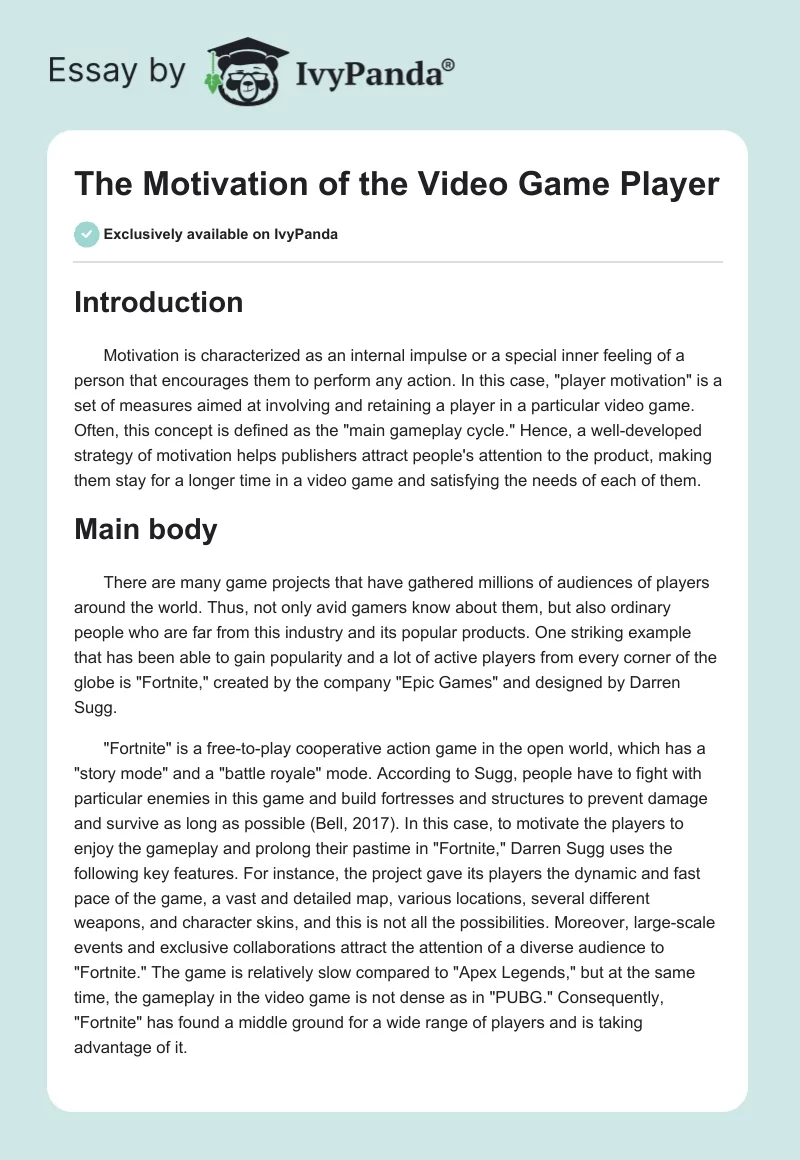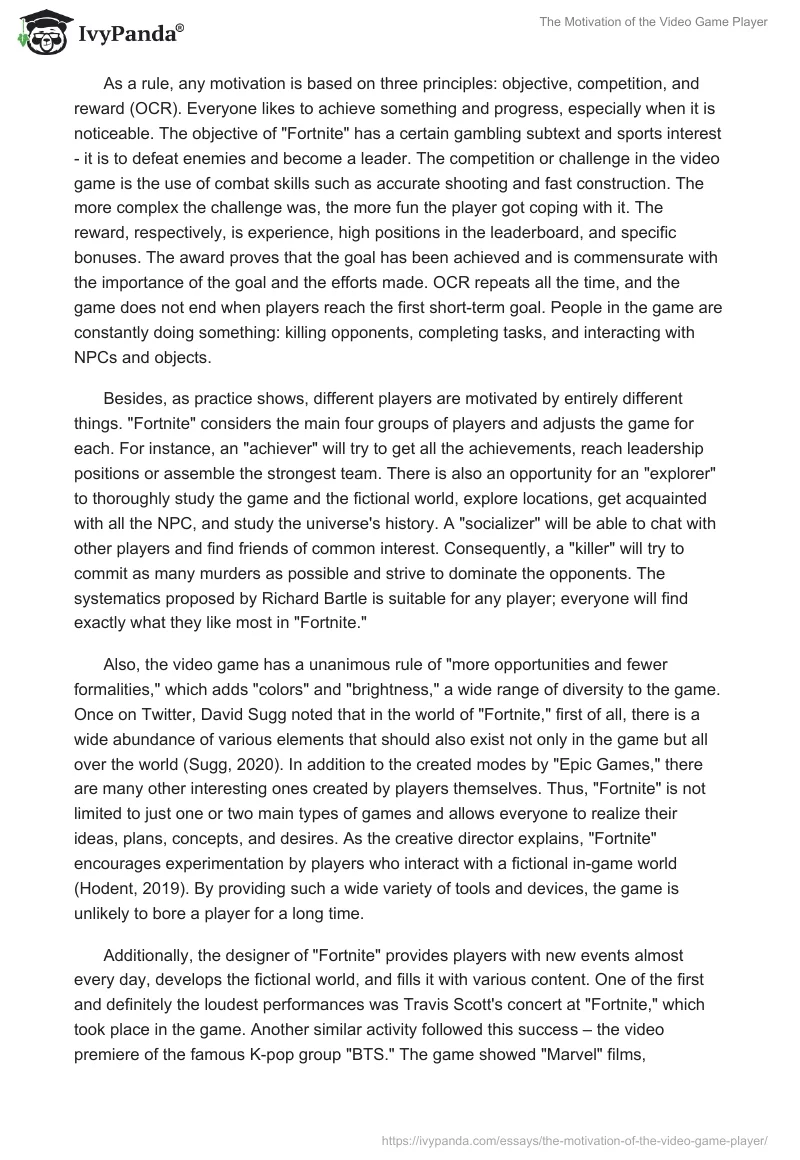Introduction
Motivation is characterized as an internal impulse or a special inner feeling of a person that encourages them to perform any action. In this case, “player motivation” is a set of measures aimed at involving and retaining a player in a particular video game. Often, this concept is defined as the “main gameplay cycle.” Hence, a well-developed strategy of motivation helps publishers attract people’s attention to the product, making them stay for a longer time in a video game and satisfying the needs of each of them.
Main body
There are many game projects that have gathered millions of audiences of players around the world. Thus, not only avid gamers know about them, but also ordinary people who are far from this industry and its popular products. One striking example that has been able to gain popularity and a lot of active players from every corner of the globe is “Fortnite,” created by the company “Epic Games” and designed by Darren Sugg.
“Fortnite” is a free-to-play cooperative action game in the open world, which has a “story mode” and a “battle royale” mode. According to Sugg, people have to fight with particular enemies in this game and build fortresses and structures to prevent damage and survive as long as possible (Bell, 2017). In this case, to motivate the players to enjoy the gameplay and prolong their pastime in “Fortnite,” Darren Sugg uses the following key features. For instance, the project gave its players the dynamic and fast pace of the game, a vast and detailed map, various locations, several different weapons, and character skins, and this is not all the possibilities. Moreover, large-scale events and exclusive collaborations attract the attention of a diverse audience to “Fortnite.” The game is relatively slow compared to “Apex Legends,” but at the same time, the gameplay in the video game is not dense as in “PUBG.” Consequently, “Fortnite” has found a middle ground for a wide range of players and is taking advantage of it.
As a rule, any motivation is based on three principles: objective, competition, and reward (OCR). Everyone likes to achieve something and progress, especially when it is noticeable. The objective of “Fortnite” has a certain gambling subtext and sports interest – it is to defeat enemies and become a leader. The competition or challenge in the video game is the use of combat skills such as accurate shooting and fast construction. The more complex the challenge was, the more fun the player got coping with it. The reward, respectively, is experience, high positions in the leaderboard, and specific bonuses. The award proves that the goal has been achieved and is commensurate with the importance of the goal and the efforts made. OCR repeats all the time, and the game does not end when players reach the first short-term goal. People in the game are constantly doing something: killing opponents, completing tasks, and interacting with NPCs and objects.
Besides, as practice shows, different players are motivated by entirely different things. “Fortnite” considers the main four groups of players and adjusts the game for each. For instance, an “achiever” will try to get all the achievements, reach leadership positions or assemble the strongest team. There is also an opportunity for an “explorer” to thoroughly study the game and the fictional world, explore locations, get acquainted with all the NPC, and study the universe’s history. A “socializer” will be able to chat with other players and find friends of common interest. Consequently, a “killer” will try to commit as many murders as possible and strive to dominate the opponents. The systematics proposed by Richard Bartle is suitable for any player; everyone will find exactly what they like most in “Fortnite.”
Also, the video game has a unanimous rule of “more opportunities and fewer formalities,” which adds “colors” and “brightness,” a wide range of diversity to the game. Once on Twitter, David Sugg noted that in the world of “Fortnite,” first of all, there is a wide abundance of various elements that should also exist not only in the game but all over the world (Sugg, 2020). In addition to the created modes by “Epic Games,” there are many other interesting ones created by players themselves. Thus, “Fortnite” is not limited to just one or two main types of games and allows everyone to realize their ideas, plans, concepts, and desires. As the creative director explains, “Fortnite” encourages experimentation by players who interact with a fictional in-game world (Hodent, 2019). By providing such a wide variety of tools and devices, the game is unlikely to bore a player for a long time.
Additionally, the designer of “Fortnite” provides players with new events almost every day, develops the fictional world, and fills it with various content. One of the first and definitely the loudest performances was Travis Scott’s concert at “Fortnite,” which took place in the game. Another similar activity followed this success – the video premiere of the famous K-pop group “BTS.” The game showed “Marvel” films, performances by “Diplo,” “Young Thug,” “Noah Cyrus,” “Marshmello,” “Ariana Grande,” and other similar events. A wide range of different activities makes a strong impression on players, increasing the already huge interest in “Fortnite” and motivation to stay in it.
Besides, “Fortnite” has a free and paid version of “battle pass,” which presents additional game content that rewards players with some pleasant bonuses for completing specific tasks and challenges. This pass is updated approximately once every three months, and along with it, tasks, locations, and characters change, which exactly will surprise any “Fortnite” fan. Thus, players are motivated by the desire to unlock all available rewards, and in some cases, they will play non-stop until all game items are unlocked.
Even though one does not have to pay anything to enter the game, developers also attract people’s attention with beautiful outfits for characters, weapons, hang gliders, and many other in-game elements for a reasonable amount. For example, more recently, the game has featured character models from “The Walking Dead” universe. Accordingly, fans of the series or comic book most likely, will purchase the appropriate items and will have fun playing for characters from this universe.
The “goods and services” offered inside the video game are not only the monetization of the project but also the motivation of players to make purchases in games, thereby forcing them to stay in “Fortnite” longer. In fact, in-game items are one of the types of predatory techniques (Fishbulb Productions, 2020). They encourage players to spend money on their favorite cosmetic items, heroes, and weapons or open new tasks and discover more exciting gameplay. As a rule, after completing microtransactions, players desire to enjoy the delight of paid purchases – they try to complete new quests and tasks and play for a while for their favorite heroes. However, taking advantage of certain psychological factors, developers manipulate their audience and force players to delay the game’s time, helping them have fun and relaxation in the digital world.
Once, “Apple” limited “Fortnite” players to enjoy shopping and the joy of new features, setting prices for in-game goods above the original cost from “Epic Games.” Tim Sweeney, the creator of Fortnite, won an “unspoken dispute” with Apple, which, in turn, violated EC legislation (Liana K, 2020). Subsequently, Epic Games achieved a certain kind of fair access and competition (Liana K, 2020). Perhaps it was one of the most high-profile conflicts in the history of the gaming industry (Liana K, 2020). Fortnite, in turn, attracted the attention of new players, and some of them continue to play to this day.
Conclusion
In conclusion, if video game companies and developers skillfully and creatively approach the concept of motivating players, then they achieve unprecedented success and prosperity. Using the example of “Fortnite,” which is famous worldwide, it is worth noting that “Epic Games” managed to fulfill this mission perfectly, consolidating its leadership position in the market of free multiplayer games. The game provides its loyal fans and new “inhabitants” with a reasonable variety of opportunities and abilities. Therefore, “Fortnite” reinforces the motivation of players to make friends and score new victories and achievements as well. In addition, regular events and musical shows reinforce the desire of people to stay there for a long time and try not to lose sight of the latest news about the world of “Fortnite.” Moreover, the leading game designer of the game was able to breathe life into this project and make the internal gameplay rich and exciting. Thanks to the talent and creativity of the designer, the game, which appeared in the heyday of its genre, was able to strengthen its position over time and get to the top of the “battle royal” market among competitors.
References
Bell, L. (2017). Fortnite creative director talks building, crafting, and saving worlds. Web.
Fishbulb Productions. (2020). The dark side of gaming with Professor Jason MacIsaac. [Video file]. Web.
Hodent, C. (2019). Understanding the success of Fortnite: A us & psychology perspective. Web.
Liana K. (2020). Why epic games Tim Sweeney is right and Kotaku is wrong regarding politics in Games. [Video file]. Web.
Sugg, D. [@DarrenSugg]. (2020). Fortnite can’t speak for itself, but in this moment I can say without a doubt it was a world built on hope [Tweet]. Twitter.


